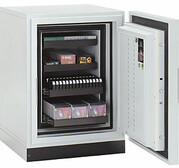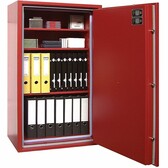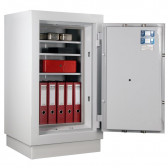If you are looking for a safe in which you plan to store valuables (some jewellery, gold, etc.), cash or documents, it is worth looking at fireproof safes. These are products that, in addition to protection against burglary, provide fire resistance confirmed by certificates issued by the Institute of Precision Mechanics or another EU-accredited research institute. Let's take a look at what options you have to choose from.
How is a fireproof safe constructed?
A fireproof safe is a special type of safe that protects the contents from high temperatures and fires. A fireproof safe consists of several layers of materials that provide thermal and mechanical insulation. Typically, a fireproof safe has a steel casing and a door that is secured with a mechanical or electronic lock. A fireproof safe is additionally equipped with insulating elements, such as concrete inserts placed between the steel walls and the door. The fireproof concrete insulation, depending on its thickness, offers different fire resistance. The thicker the concrete layer, the longer the fire-resistant safe can withstand high temperatures without damaging the contents. The fireproof safe should comply with the relevant standards and certificates, which specify the time and temperature at which the fireproof safe is effective. In addition, modern safes use salt solution panels, as salt is an excellent insulator of heat. The fire seal around the door is also an important part of the construction, which swells when exposed to high temperatures and protects the gaps in the structure. As you can see, these are not just any metal cabinets, but effective protection against fire and burglary.
What are the fire resistance classes?
There are several classes of fire resistance differing in the fire resistance expressed in time, but also in the material that will be safe in a particular safe, for example, there is a different class for fire safes protecting paper documents and another for data carriers.
Fire resistance of 30 minutes
LFS30 fire durability is the level of fire resistance that provides protection against fire for at least 30 minutes. Although the LFS30 grade is a basic resistance, it is found not only in devices such as a lightweight home safe, but also in powerful and heavy burglary safes. It is noteworthy that in safes, the mounting holes in the walls of the safe do not affect the fire resistance class of the overall structure.
Fire resistance of 60 and 120 minutes for paper documents
If securing documents and cash against fire is a priority for you, fireproof safes in classes S60P (one hour) or S120P (two hours) are a good idea. These are restrictive classes confirmed by physical tests that involve burning the safes in a metallurgical furnace. Such a test is designed to verify resistance in the event of a fire, and the dropping of a heated safe from several metres onto concrete provides additional protection in the event of a ceiling collapse in a house. Fireproof safes of this type are relatively heavy, equipped with a system of external hinges and seals on the door. Enhanced protection against fire and burglary is provided by the multi-walled construction.
Fireproof 60- and 120-minute safes for data carriers
Slightly different products are fireproof safes designed for storing electronic storage media. As these are more temperature-sensitive items than paper, the construction of such a safe must be more complex, stronger and heavier. Hence, specialized fireproof safes for data carriers are relatively large and heavy. even among other fireproof safes. Such models can be distinguished by an interior with compartments for tapes and disks, as well as a drawer-like opening door.
Which lock to choose?
A fireproof safe, like any other, can be locked in several ways. Which lock on a safe is best? This depends on a number of factors, such as the level of security, ease of use, cost and user preferences. There are three main types of safe locks: mechanical, electronic and biometric. Each has its own advantages and disadvantages that should be taken into account when choosing.
Mechanical lock
Is the most traditional and reliable way of securing a safe. It consists of a dial with numbers and levers that must be set in the correct combination to open the safe. A mechanical lock does not require power or batteries, meaning there is no risk of failure or discharge. It is also resistant to attempted break-ins and tampering. However, a mechanical lock requires precision and patience when opening the safe, which can be cumbersome in emergency situations. In addition, the combination is fixed and difficult to change.
Electronic lock
Is a modern and convenient way to secure a safe. It consists of a numeric or touch-sensitive keypad, on which a PIN code must be entered to open the safe. The electronic lock allows a quick and easy access to the safe, as well as the ability to change the code at will. Some electronic locks have additional features, such as alarms, time delays or blockages when a wrong code is entered.
Biometric lock
Is the most advanced and innovative way to secure a safe. It consists of a fingerprint reader that scans the user's fingerprint, compares it with a preprogrammed pattern and opens the safe. The biometric lock guarantees the fastest access to the safe and the highest level of security, as it is impossible for unauthorized persons to break through. The biometric lock is also environmentally friendly, as it is powered by low-current from the home grid without the use of alkaline batteries. However, the biometric lock is the most expensive of the types of locks we have outlined, making it unaffordable for everyone. In addition, it can be unreliable if the reader gets dirty or the fingerprint changes.
In conclusion, the choice of a safe lock depends on the individual needs and capabilities of each user. Each type of lock has its own strengths and weaknesses, which should be considered before making a decision. There is no one-size-fits-all solution that fits every safe and every situation.
Also read the article about changing the cipher on the most popular types of safe locks.
So which fireproof safe should you choose?
Preferably one that suits you best. Our assortment includes dozens of models in varying standards, different colors and sizes. One thing is certain, whatever you buy in our store, it will be a device designed to store valuable items, documents, locked with a secure and certified lock. Fireproof safes are plentiful, and for both home and office, it will be a good choice.





